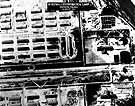
|
|
|

|

|

|

|
|
Click on an image to see a larger, more detailed picture.
|
|
|
|
|
| 1944: Desperate Acts |

|
pg. 554 |

|
|
|
|
| |
 Russian soldiers are joyously received by Romanians in Bucharest in August 1944. But liberation was too late for hundreds of thousands of Romanian Jews who were butchered by native antisemites and German Einsatzgruppen. In all, upwards of 420,000 Jews of Romania perished under Nazi rule.
Russian soldiers are joyously received by Romanians in Bucharest in August 1944. But liberation was too late for hundreds of thousands of Romanian Jews who were butchered by native antisemites and German Einsatzgruppen. In all, upwards of 420,000 Jews of Romania perished under Nazi rule.
Photo: Suddeutscher Verlag Bilderdienst
|
 Allied reconnaissance aircraft regularly flew over and photographed the Auschwitz-Birkenau death camp. Crematoria and gas chamber units as well as numerous barracks and guard towers are clearly visible. Even some of the prisoners can be seen, as can the tracks that brought the trainloads of victims to the camp. The Allies, who decided that the best way to put an end to the atrocities committed at Auschwitz was to win the war quickly, made no effort to bomb the camp.
Allied reconnaissance aircraft regularly flew over and photographed the Auschwitz-Birkenau death camp. Crematoria and gas chamber units as well as numerous barracks and guard towers are clearly visible. Even some of the prisoners can be seen, as can the tracks that brought the trainloads of victims to the camp. The Allies, who decided that the best way to put an end to the atrocities committed at Auschwitz was to win the war quickly, made no effort to bomb the camp.
Photo: AP/Wide World
|
|
Why Wasn't Auschwitz Bombed? On August 9, 1944, U.S. Assistant Secretary of War John J. McCloy was sent a message from Ernst Frischer, a Jewish member of the London-exiled Czechoslovak State Council. Frischer wanted Auschwitz bombed. In Allied and Jewish circles alike, opinion was divided about the feasibility of such action, but Frischer's plea was neither the first nor the last of its kind. McCloy acknowledged the request's "humanitarian motives" but rejected it nonetheless. "A study," McCloy claimed, showed that bombing Auschwitz would require "the diversion of considerable air support." Bombing would be of "doubtful efficacy" and "might provoke even more vindictive action by the Germans." McCloy's less than straightforward arguments camouflaged the confidential policy prepared by the War Department in January: American military forces would not be "employed for the purpose of rescuing victims of enemy oppression unless such rescues are the direct result of military operations conducted with the objective of defeating the armed forces of the enemy." In June 1944 the Allies began to consider bombing the synthetic-oil and rubber factories connected to Auschwitz. Subsequent aerial reconnaissance photographs show the Auschwitz complex. During a raid on August 20, American planes dropped 1336 500-pound bombs on factory areas less than five miles from the camp's gas chambers. Controversy remains about the reluctance to bomb Auschwitz. It now seems clear, however, that bombing in the spring and summer of 1944 would have saved many lives.
|
|

|

|

|

|
 September 1944: Five thousand women and 500 men are evacuated from Auschwitz north to Stutthof, Germany. Three thousand interned women are evacuated from Auschwitz northwest to Neuengamme, Germany.
September 1944: Five thousand women and 500 men are evacuated from Auschwitz north to Stutthof, Germany. Three thousand interned women are evacuated from Auschwitz northwest to Neuengamme, Germany.
|
 September 1944: Following American bomber hits on factories at Auschwitz, the SS gives wounded inmates excellent medical attention as well as flowers and chocolate--a propaganda ploy for the benefit of German media. Once recovered, the inmates are exterminated.
September 1944: Following American bomber hits on factories at Auschwitz, the SS gives wounded inmates excellent medical attention as well as flowers and chocolate--a propaganda ploy for the benefit of German media. Once recovered, the inmates are exterminated.
|
 September 1944: The Gestapo and SS men in Przemysl, Poland, execute eight members of a non-Jewish Polish family and a little Jewish girl after discovering the group playing together in a courtyard.
September 1944: The Gestapo and SS men in Przemysl, Poland, execute eight members of a non-Jewish Polish family and a little Jewish girl after discovering the group playing together in a courtyard.
|
|
|
|
|
| 1944: Desperate Acts |

|
pg. 554 |

|
|
The Holocaust Chronicle
© 2009 Publications International, Ltd.
|
|
